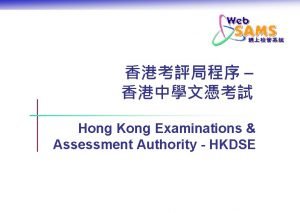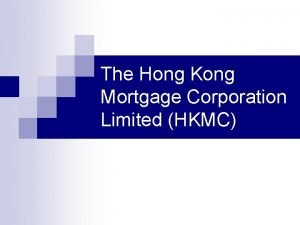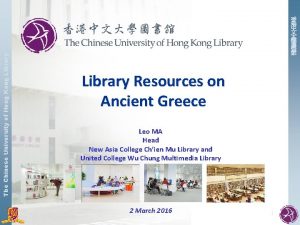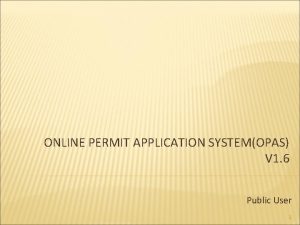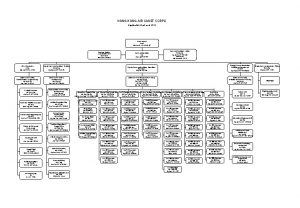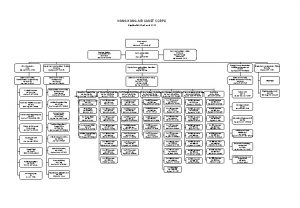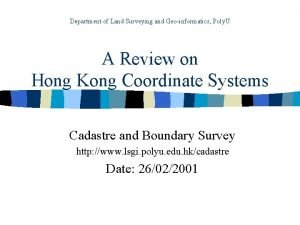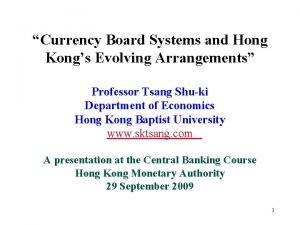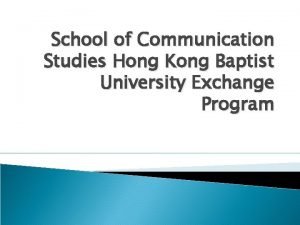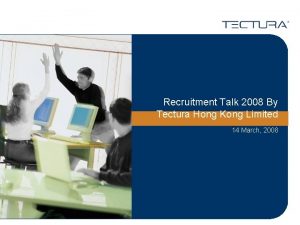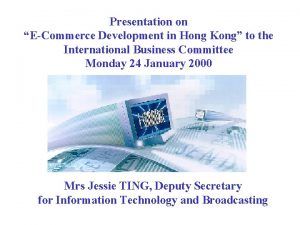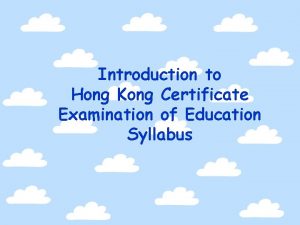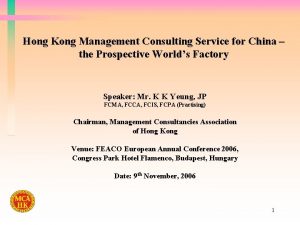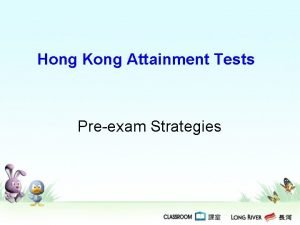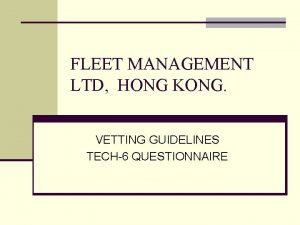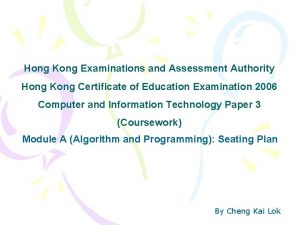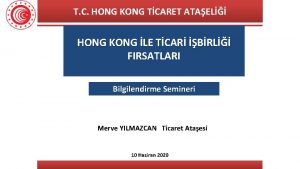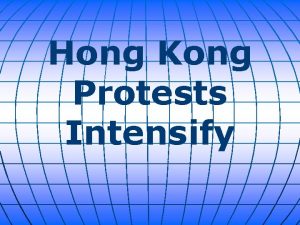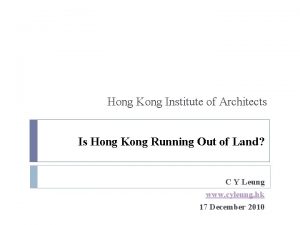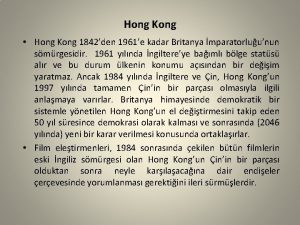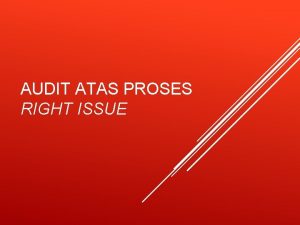Right Issue and Open Offer in Hong Kong





























- Slides: 29

Right Issue and Open Offer in Hong Kong April 2014 www. charltonslaw. com 0

Conceptual Differences between a Rights Issue and an Open Offer Rights Issue • An offer by way of rights to existing holders of securities which enables those holders to subscribe securities in proportion to their existing holdings (MB Rule 7. 18). • Rights issues are normally required to be conveyed by renounceable provisional letters of allotment or other negotiable instrument (MB Rule 7. 20). • The rights offered to an existing shareholder are normally traded as separate temporary securities from the parent share, commonly referred to as nil paid rights (NPR). Open Offer • An offer to existing holders of securities to subscribe securities, whether or not in proportion to their existing holdings, which are not allotted to them on renounceable documents (MB Rule 7. 23). • The rights offered to an existing shareholder under an open offer cannot be traded on the open market. • Shareholders can either take up and exercise the rights to purchase new shares at the offer price, or allow the rights to lapse upon expiration.

Practical Differences between a Rights Issue and an Open Offer Example of a rights issue • Mr. X owns 1, 000 shares in Company A with each share trading at HK$2 on the stock exchange. • Company A currently: • has 1, 000 shares in circulation (i. e. with market capitalisation of HK$2, 000); • needs to raise HK$375, 000 (before expenses); and • proposes to issue 250, 000 new ordinary shares • Existing shareholders are offered the right to purchase 1 new share in Company A for every 4 shares they currently hold (ie a 1: 4 Rights Issue). • The new shares are offered to the existing shareholders at a discounted price of HK$1. 5 (HK$375, 000 / 250, 000).

Practical Differences between a Rights Issue and an Open Offer (cont’d) Example of a rights issue (cont’d) • The share price adjusts proportionately: • Price before the rights issue is HK$2 per share. • Typically, when a company makes a rights issue one can expect the market value of the shares to fall as they are increasing the number of shares in circulation. • Initial shares in circulation = 1, 000 shares @ HK$2 = HK$2, 000 • After rights issue = (1, 000 x HK$2) + (250, 000 x HK$1. 5) = HK$2, 375, 000 / number of shares in issue. • Theoretical ex-rights price per share = £ 2, 375, 000/1, 250. 000 = HK$1. 9

Practical Differences between a Rights Issue and an Open Offer (cont’d) Options for existing shareholders in a rights issue Accept in full or in part • By exercising in full all the rights entitlements offered under the rights issue, the shareholder can maintain his proportionate ownership in the company with the enlarged share capital without experiencing shareholding dilution. • In the case of a discounted rights issue, the stock market will, on the Ex-Date, price into the share price the effect of shareholding dilution as a result of the new additional shares issued. • Once the shares are traded on ex-rights basis, the share price will drop to theoretical exrights price (i. e. HK$1. 9 in the example). • However, this loss as a result of a fall in market share price is offset by the gain made when Mr. X subscribed the new shares at HK$1. 5, a 25% discount to the market price of HK$2 per share trading on cum-rights basis.

Practical Differences between a Rights Issue and an Open Offer (cont’d) Options for existing shareholders in a rights issue (cont’d) Decline the offer, allowing the NPR to lapse upon expiration • By allowing the rights entitlements to lapse upon expiration, the shareholder’s stake in the company will be diluted together with a reduction in the value of his shareholdings following the conclusion of the rights issue. Renounce and trade the NPR • The shareholder’s stake in the company will be diluted. • However, the shareholder can gain by selling his rights entitlements away in the open market to compensate for the fall in value of his shareholdings. Estimated value of NPR = Theoretical ex-rights price – new shares offer price = HK$1. 9 – HK$1. 5 = HK$0. 4 per rights entitlement

Practical Differences between a Rights Issue and an Open Offer (cont’d) v From the company's perspective, open offers may be cheaper as shares are usually offered at a finer discount than on a rights issue. v From the shareholders’ perspective, open offers do not allow them to gain from the tradable NPR in case they do not wish to subscribe for the new shares. v Where companies seek to raise a substantial amount through an equity issue, they are more likely to use a rights issue than an open offer due to greater investor familiarity with rights issues and the greater flexibility they offer shareholders.

Procedural Differences between a Rights Issue and an Open Offer Rights Issue Listing document Open Offer Publication of a prospectus which: Same as rights issue (see • states, inter alia, the basis of subscription, the Main Board Rules reason for the issue, the use of proceeds 11. 09(2)). • contain contents as set out in Part B of Appendix 1 of the Listing Rules (but excluding paragraphs 8, 24, 26(1), (3)-(5) and 43(4)) • shall include a statement from each substantial shareholder as to whether that substantial shareholder has undertaken to take up its entitlement in full or in part and on what conditions, if any, and relevant particulars. • will be registered with the Companies Registry in accordance with the Companies Ordinance

Procedural Differences between a Rights Issue and an Open Offer (cont’d) Underwriting Rights Issue Open Offer Normally fully underwritten unless the prior consent of the HKEx to do otherwise has been obtained • HKEx may permit rights issue which is not underwritten in certain circumstances (e. g. where additional costs of underwriting are not justified in particular circumstances; or where an underwriting commitment was terminated by a force majeure event after offer opened; or to facilitate fund-raising by very substantial companies) subject to compliance with additional disclosure requirements othe fact that the rights issue is not fully underwritten; othe minimum amount, if any, that must be raised before the issue will proceed; othe intended application of net proceeds of issue according to the level of subscriptions Same as rights issue except that there is no additional disclosure requirement in case underwriting could be terminated on occurrence of force majeure events after dealings of rights in nil-paid form has commenced (see Main Board Rules 7. 24(1), 7. 24(2), 7. 24(3) & 7. 24(4)).

Procedural Differences between a Rights Issue and an Open Offer (cont’d) Rights Issue Underwriting (Cont’d) • additional disclosures (including risk disclosures) must be included in listing document if underwriting could be terminated on occurrence of force majeure events after dealings of rights in nil-paid form have commenced • if a rights issue is not fully underwritten, a substantial shareholder who applies to take up its full entitlement may unwittingly incur an obligation to make a general offer under the Takeovers Code unless a waiver from the Executive is obtained. If this is likely to occur, the issuer may permit the substantial shareholder to scale-down its commitment in the case that the issue is not fully taken up to avoid a general offer obligation Open Offer Same as rights issue except that there is no additional disclosure requirement in case underwriting could be terminated on occurrence of force majeure events after dealings of rights in nil-paid form has commenced (see Main Board Rules 7. 24(1), 7. 24(2), 7. 24(3) & 7. 24(4)).

Procedural Differences between a Rights Issue and an Open Offer (cont’d) Rights Issue Underwriting (Cont’d) • if not fully underwritten by a person or persons whose ordinary course of business includes underwriting, the listing document must contain full disclosure of that fact Open Offer Same as rights issue except that there is no additional disclosure requirement in case underwriting could be terminated on occurrence of force majeure events after dealings of rights in nil-paid form has commenced (see Main Board Rules 7. 24(1), 7. 24(2), 7. 24(3) & 7. 24(4)).

Procedural Differences between a Rights Issue and an Open Offer (cont’d) Rights Issue Where the issued share capital or market capitalisation will increase by more than 50% (taking into account rights issues & open offers announced (i) in the previous 12 months or (ii) earlier where dealing in shares issued commenced in the previous 12 months) Open Offer There additional applicable Listing Rules Same as rights issue requirements which include: (see Main Board Rules • independent shareholders’ approval: the approval of 7. 24(5), 7. 24(8)) independent shareholders in general meeting would need to be obtained where controlling shareholders and their associates (or where there is no controlling shareholder, the directors (other than INEDs) and the chief executives) must abstain from voting in favour of the resolution approving the rights issue (Main Board Rule 7. 19(6)) • independent board committee must be established to advise shareholders as to terms of rights issue and whether they are fair and reasonable and how they should vote – a statement of the committee must be included in the circular

Procedural Differences between a Rights Issue and an Open Offer (cont’d) Rights Issue Where the • issued share capital or market capitalisation will increase by • more than 50% (Cont’d) Open Offer independent financial adviser must be Same as rights issue (see appointed to make recommendations to the Main Board Rules 7. 24(5), independent board committee – a statement 7. 24(8)) of the adviser must be included in the circular additional disclosures: the circular to shareholders must include descriptions of the purpose of proposed rights issue, the total funds expected to be raised, detailed breakdown and description of proposed use of proceeds of the current issue and in respect of any equity issues in the preceding 12 months

Procedural Differences between a Rights Issue and an Open Offer (cont’d) Rights Issue Provisional letters of allotment Open Offer Renounceable provisional letters of allotment, By reason of the nature of letter of rights or other negotiable instrument for open offers, this all shareholders: requirement is not applicable. • provisional allotment letters inform shareholders of the number of shares provisionally allotted to them • letter of rights informs shareholders that they have the right to buy a specific number of new shares at a specific price • any such letters must state the time, being not less than 10 business days, during which the offer may be accepted

Procedural Differences between a Rights Issue and an Open Offer (cont’d) Rights Issue Shares in excess Open Offer An issuer can make arrangements to dispose An issuer can make of rights shares not taken up by present arrangements to dispose of shareholders – this can be done either by: shares not applied for by • issuing excess application forms to allowing applications for shareholders along with provisional allotment excess shares (these must be letters to enable shareholders to subscribe available for subscription by for additional shares in the company (excess all shareholders and allocated shares must be available for subscription by on a fair basis). all shareholders and allocated on a fair basis); (see Main Board Rule 7. 26(A)). Offers of excess shares and or the basis of allocation must be • selling the excess shares in the market, if disclosed in the open offer possible, for the benefit of the persons to announcement, listing whom the rights shares were offered. (Main document and any circular. Board Rule 7. 21(1))

Procedural Differences between a Rights Issue and an Open Offer (cont’d) Rights Issue Shares in excess (Cont’d) Open Offer v Offers of excess shares and the basis of allocation Listing Rules do not provide for must be disclosed in rights issue announcement, issuers to sell the excess shares listing document and circular. in the market for the benefit of the persons to whom the open v If no arrangements or arrangements other than offer was made. those described above have been made for disposal of rights shares not taken up, and the Independent shareholders’ rights issue is wholly or partly underwritten or sub approval is required if no -underwritten by a director, chief executive or arrangements substantial shareholder or their associates, then other than those described the absence of such arrangements or the making above are made for disposal of of other arrangements must be approved by the shares not taken up if the open issuer’s independent shareholders. offer is underwritten or sub/underwritten by a director, chief executive or substantial shareholder (or their associates).

Procedural Differences between a Rights Issue and an Open Offer (cont’d) Rights Issue Excluded shareholders Open Offer General rule under Main Board Rule 13. 36 is that Same as rights issue. a pro rata rights issue does not require shareholders’ approval. Main Board Rule 13. 36(2)(a) allows issuers to exclude shareholders resident outside Hong Kong from the rights issue where: • the issuer has made enquiries regarding the legal restrictions under the laws of the relevant place and requirements of relevant regulatory body or stock exchange; and • based on those enquiries, the issuer’s directors consider it necessary or expedient not to offer the rights shares to overseas shareholders.

Procedural Differences between a Rights Issue and an Open Offer (cont’d) Excluded shareholders (cont’d) Rights Issue Open Offer Usually, a legal opinion from overseas counsel in relevant jurisdictions is required for the directors to form such a view and pass resolutions accordingly approving the exclusion of certain overseas shareholders. Same as rights issue. If overseas shareholders are excluded under MB Rule 13. 36(2)(a), an explanation for the exclusion must be included in the relevant circular or document containing the offer. Issuers should also deliver the circular or offer document to excluded shareholders for information, subject to compliance with local laws and regulations. If an issuer has shareholders in a large number of overseas jurisdictions, it may not be practical to obtain legal opinions from all relevant jurisdictions. Shareholders’ approval will be required if the issuer will exclude overseas shareholders without obtaining legal opinions for all relevant jurisdictions.

Procedural Differences between a Rights Issue and an Open Offer (cont’d) Rights Issue Open Offer period The offer period during which the rights shares may Same as rights issue (see be accepted must be at least 10 business days. Main Board Rule 7. 25). Where an issuer proposes an offer period of more than 15 business days, e. g. where there a large number of overseas shareholders, the Exchange must be consulted. (Main Board Rule 7. 20) Closure of books An issuer must announce any closure of its transfer books or register of members in respect of securities listed in Hong Kong at least 6 business days before the closure of books. (Main Board Rule 13. 66(1)) An issuer must announce any closure of its transfer books or register of members in respect of securities listed in Hong Kong at least 10 business days before the closure of books. (Main Board Rule 13. 66(1))

Procedural Differences between a Rights Issue and an Open Offer (cont’d) Rights Issue Last day for trading in the securities with entitlements An issuer must ensure that the last day for trading in the securities with entitlements falls at least 1 business day after the general meeting, if the entitlements require the approval of shareholders in the general meeting or are contingent on a transaction that is subject to the approval of shareholders in the general meeting. Open Offer Same as rights issue save that there is no requirement for 2 trading days for trading in the securities with entitlements after publication of the book closure (see Main Board In addition, for a rights issue, the issuer must Rule 13. 66). provide at least 2 trading days for trading in the securities with entitlements (i. e. before the exdate) after publication of the book closure.

Procedural Differences between a Rights Issue and an Open Offer (cont’d) Rights Issue Shareholders’ meeting Open Offer General rule under Main Board Rule 13. 36 is that Same as rights issue. a pro rata rights issue does not require shareholders’ approval. However, where an open offer is made to existing As stated above, shareholders’ approval will be shareholders not in required if: proportion to their existing shareholdings, i) the rights issue will increase the issued shareholders’ approval in capital or market capitalisation by more than general meeting will be 50% (either alone or when aggregated with required unless the issuer rights issues or open offers announced in the will issue the offer shares previous 12 months or earlier where dealing in under a general mandate the new shares started in the previous 12 in accordance with Main months); Board rule 13. 36(2).

Procedural Differences between a Rights Issue and an Open Offer (cont’d) Shareholders’ meeting (cont’d) Rights Issue Open Offer ii) no arrangements or arrangements other than those in MB Rule 7. 21(1) are made for the disposal of rights shares not taken up and the rights issue is wholly or partly underwritten or sub-underwritten by a director, chief executive or substantial shareholder of the issuer; or The general mandate cannot exceed 20% of the issued share capital of the issuer at the date of the general mandate. The shareholders can also separately authorise the iii) where overseas shareholders are to be issuer to issue shares excluded (unless the conditions specified equivalent to the number of in MB Rule 13. 36(2)(a) are met) shares repurchased since the date of the general mandate (up to a maximum number equivalent to 10% of the existing issued share capital)

General Mandates • The Listing Rules generally require shareholders’ prior approval in general meeting for any allotment, issue or grant by an issuer of shares, securities convertible into shares or options, warrants or similar rights to subscribe for shares or such convertible securities (MB Rule 13. 36(1)(a)) • Shareholders’ approval is not generally required where the offer is made to all shareholders pro rata to their existing shareholdings (MB Rule 13. 36(2)(a)) • Shareholders’ approval is not required where the issuer’s shareholders have by ordinary resolution in general meeting given a general mandate to the issuer’s directors to allot or issue such securities (or grant options or warrants to subscribe for such securities) (MB Rule 13. 36(2)(b)) • A general mandate is normally approved at the AGM and remains valid until the next AGM unless varied or revoked by ordinary resolution in general meeting. • Shares cannot be issued to connected persons under a general mandate unless the connected transaction requirements under Chapter 14 A are complied with. • In the case of rights issues and open offers made pro rata to existing shareholders (which would not require reliance on a general mandate), securities issued to connected persons pro rata in their capacity as shareholders are exempt from the connected transaction requirements (MB Rule 14 A. 31(3)(a)).

Rights Issue Timetable (assuming no general meeting for shareholders’ approval) Event Remarks Timeline Publication of the rights issue At least six business days (i. e. five clear business Day 1 announcement (including days) before the book closure (Monday) timetable) on Exchange news website Last day of dealings in The business day immediately before the ex- Day 4 securities on cum-rights basis date. (Thursday) Ex-date (the first day of There must be at least 2 uninterrupted trading Day 5 dealings in securities on ex- days for trading cum-rights between the rights basis) announcement of book closure and the ex-date. (Friday) Days 6 & 7 (Saturday and Sunday) are not “business days”

Rights Issue Timetable (assuming no general meeting for shareholders’ approval)(cont’d) Event Remarks Timeline Latest time for lodging transfers of shares to qualify for the rights issue 4: 30 pm on Day 8 (Mon) Register of members closes Timetable assumes the register closes for 3 days Days 9 -11 (Tues- Thurs) Record date for rights issue Any day during the closure of the register of Day members period (Thurs) Despatch of PALs 11 Day 12 (Fri) Days 13 & 14 (Saturday and Sunday) are not “business days” First day of dealing in NPR Two business days after the despatch of PAL Latest time for splitting of PAL At least three working days before the last dealing Day day (Thurs) Days 20 & 21 (Saturday and Sunday) are not “business days” Day (Tues) 16 18

Rights Issue Timetable (assuming no general meeting for shareholders’ approval)(cont’d) Event Remarks Last day of dealings in NPR Latest time for acceptance and • payment for rights shares and application for excess rights • shares Timeline Day (Tues) Three working days after last day for dealing Day 26 NPR (to allow for settlement on T+2) (Fri) The offer period should not be less than 10 business days. 23

Charltons is a firm with extensive experience in corporate finance and in-depth knowledge of Hong Kong law and practice Representative offices in Shanghai, Beijing and Myanmar “Corporate Finance Law Firm of the Year in Hong Kong” awarded to Charltons in the Corporate INTL Magazine Global Award 2014 “Boutique Firm of the Year” awarded to Charltons by Asian Legal Business for the years 2002, 2003, 2006, 2007, 2008, 2009, 2010, 2011, 2012, 2013, 2014 and 2015 “Hong Kong's Top Independent Law Firm” awarded to Charltons in the Euromoney Legal Media Asia Women in Business Law Awards 2012 and 2013 “Equity Market Deal of the Year” awarded to Charltons in 2011 by Asian Legal Business for advising the AIA IPO “Asian Restructuring Deal of the Year” 2000 awarded to Charltons by International Financial Law Review for their work with Guangdong Investment Limited.

Contact Us Hong Kong Office Dominion Centre 12 th Floor 43 – 59 Queen’s Road East Hong Kong Telephone: Fax: Email: Website: (852) 2905 7888 (852) 2854 9596 enquiries@charltonslaw. com http: //www. charltonslaw. com 27

Other Locations China In association with: Beijing Representative Office Shanghai Representative Office 3 -1703, Vantone Centre A 6# Chaowai Avenue Chaoyang District Beijing People's Republic of China 100020 Room 2006, 20 th Floor Fortune Times 1438 North Shanxi Road Shanghai People's Republic of China 200060 Telephone: (86) 10 5907 3299 Facsimile: (86) 10 5907 3299 enquiries. beijing@charltonslaw. com Telephone: (86) 21 6277 9899 Facsimile: (86) 21 6277 7899 enquiries. shanghai@charltonslaw. com Networked with: Myanmar Yangon Office of Charltons Legal Consulting Ltd 161, 50 th Street Yangon Myanmar enquiries. myanmar@charltonslaw. com 28
 Right product right place right time right price
Right product right place right time right price Family time
Family time Hong kong and shanghai banking corporation ap world history
Hong kong and shanghai banking corporation ap world history Web sams
Web sams Sip early offer vs delayed offer
Sip early offer vs delayed offer The hong kong mortgage corporation limited
The hong kong mortgage corporation limited The hong kong institute of chartered secretaries
The hong kong institute of chartered secretaries Chinese university of hong kong library
Chinese university of hong kong library Smbhk
Smbhk Rectangular population pyramid
Rectangular population pyramid Extranetapps hongkongairport com/opas/public
Extranetapps hongkongairport com/opas/public Hong kong diploma of secondary education examination
Hong kong diploma of secondary education examination Airport authority hong kong organisation chart
Airport authority hong kong organisation chart Hong kong air cadet corps
Hong kong air cadet corps Polyu surveying
Polyu surveying Currency board hong kong
Currency board hong kong Hong kong weather symbols
Hong kong weather symbols Bloomberg academy hong kong
Bloomberg academy hong kong Gyeongu
Gyeongu Hong kong budding poets (english) award online platform
Hong kong budding poets (english) award online platform Urban decay problem in hong kong
Urban decay problem in hong kong Hong kong baptist university school of communication
Hong kong baptist university school of communication Tectura hong kong limited
Tectura hong kong limited Ecommerce development hong kong
Ecommerce development hong kong Russian companies listed in hong kong
Russian companies listed in hong kong Hong kong certificate of education examination
Hong kong certificate of education examination Management consulting hong kong
Management consulting hong kong Hong kong chemistry olympiad
Hong kong chemistry olympiad Hong kong attainment test
Hong kong attainment test Fleet management ltd hong kong
Fleet management ltd hong kong



